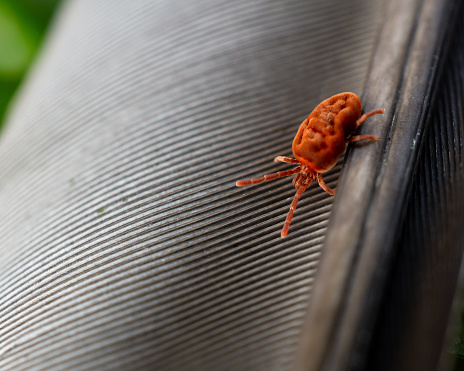Every bug is a problem in some way. Some cause trouble to us while some cause damage to our belongings. Clover mites come in the second category.
They do not cause any trouble to us but might damage our belongings. In this article, we are going to discuss ways that will help us in getting rid of them.
This article is going to cover everything about clover mites, from the damages they cause to the preventive measures required to be taken.
Let us discuss why it is important to get rid of them.
Why Is It Important to Eliminate Clover Mites?
One thing that needs to be cleared up is that clover mites don’t harm us at all. They do not bite us.
They are not thirsty for our blood or any other species’ blood. They acquire their nutrition from plants, grass, shrubs, trees, and other plants. Because of this, they do not cause any structural damage either.
They are just a nuisance but that doesn’t mean they are okay to have around. The only things that might get damaged due to the presence of clover mites are our belongings. They have to be eliminated and we have mentioned the reasons for elimination below.
- If no preventive measures are taken, clover mites can invade your house. They can multiply themselves quickly, so thousands of clover mites can likely invade your house, especially when the weather is cooler.
- When they are smashed, they leave tiny bright red pigments. All our curtains, rugs, carpets, mattresses, and walls are always at risk of having these stains if clover mites are present in our house.
- Since their diet contains over-fertilized grass, plants, flowers, clover, and other vegetation, the chances of your yard getting damaged by them are very high.
Reasons For the Presence of Clover Mites
After reading the above section, it is now clear that clover mites prefer vegetation over us. And this is the reason that clover mites are attracted to our house. Our yard provides them with an environment that is very suitable for them to build their nest and survive.
When they come to your yard, you might discover uneven patches of grass on a well-maintained lawn, you may even locate them crawling on the fences or the exterior of your house.
The thick shrubs and vegetation present in your yard provide mites with a perfect environment. They mostly arrive in cooler weather, and their activity peaks when the temperature goes down.
In spring and early fall, when the plants in your yards thrive, clover mites’ population increases at an impressive speed.
They also flourish in well-fertilized lawns, can enter your house through any tiny openings or by climbing the home sliding, and can get into the attic and upper levels of your house.
Identifying the Infestation
Identifying a clover mite infestation is a difficult task to perform as they are very small in size. But the task is difficult, not impossible.
They are also good at sneaking through the cracks and holes present in the walls. The holes through which they enter are so small that you would require a magnifying glass to find them and seal them. This again makes the detection of clover mites tough for homeowners.
To make this job possible, we are listing some points that will help you in identifying clover mites’ infestation.
- Tiny red pigments around the plants and grass can indicate the presence of clover mites. Also, they can be seen crawling on the siding and window sills of your house.
- A large number of clover mites can be found near the foundations of buildings or areas such as tree trunks, windows, walls, etc. All these places are preferred hiding spots for mites.
- During the colder months, do a regular check of the entry points around the windows and doors of your house. If any cracks are present which are not been treated, then check them too. Clover mites seek shelter and warmth during the colder months therefore they might use all these entry points to invade your home.
- For those homeowners who have kept plants inside their houses, it is advised to do a regular checkup of potted plants. Also, look for red pigments on curtains, rugs, furniture, walls, etc.
How to Get Rid of Clover Mites?
Now that you know how to identify an infestation, it’s time to move on to our main topic i.e how to get rid of clover mites. There are many techniques to eliminate mites including some home remedies as well. We have listed them below.
Removing Clover Mites Manually
Clover mites can be removed manually by using a vacuum cleaner. You can spot them with the help of their bright red color. Remember do not squash them, as they leave red spots behind them if squashed.
To eliminate them properly, using a vacuum cleaner is advised, and also throw its dust bag far away from your property. Never throw it around your yard, as clover mites might come back.
Using a Sponge
All the targeted areas such as tables, chairs, windows, and doors can be wiped with the help of a sponge. All you have to do is mix some dishwasher in water and using a sponge wipe the targeted areas.
The scent of the soap will act as a repellent that will prevent clover mites from coming back. You can add some more repellents to make the scent stronger.
Do not press the sponge too hard, as it may squash the clover mites, and as mentioned earlier, squashing them will leave red stains on all your stuff.
Boric Acid
Boric acid can be used to eliminate clover mites as it not only kills them but also acts as a barrier for them. Sprinkle the boric acid on the targeted areas, it will kill the clover mites present there and will prevent them from coming back by acting as a barrier.
Sprinkle the boric acid powder along the perimeters of rooms, rugs, carpets, couches, doors, walls, outdoor structures, fences, around the yard, and foundation.
Reapplying might be required as boric acid may get washed away by rain or may get blown away by the wind.
Vinegar
Using vinegar you can make your clover mite killer. Just mix vinegar with water and fill the solution in a spraying bottle. Spray it into the targeted areas.
Before spraying it on the lawn, try to test the mixture as vinegar is highly acidic and might cause damage to your yard.

Soap Water
Just like vinegar, soap can also be used for making a clover mite killer. By taking a few drops of dishwashing or liquid laundry detergent in water, a clover mite killer can be prepared.
Spraying it over clover mites will suffocate them and ultimately kill them. Remove the dead mites using a vacuum cleaner.
Diatomaceous Earth
Diatomaceous earth, also known as DE is a natural mite repellent. A pure, food-grade DE is available in the market, you can purchase it from the market and then sprinkle it around the targeted areas.
It will create a barrier that will not allow clover mites to come back. DE can be placed under the doors, or around the yard.
Baby Powder
To prevent clover mites from entering your bed, line the baby powder around the bed frame and mattress. Baby powder is a very good mites repellent and can be sprinkled in the perimeter and corners of the rooms.
Baking soda
It does not kill clover mites but is very effective in repelling them. Using baking soda is an excellent way to repel mites naturally and prevent them from entering your house.
You can create a boundary using baking soda around your yard. This will trap the already present mites as they won’t be able to cross that boundary. You can now treat them with ease. Also, it will prevent new mites from entering your yard.
Baking soda can also be sprinkled around the doors, windows, and rooms. This will help in controlling mites and will make the management task easy.
Bifen IT
If you have tried all the above-mentioned methods and still have not gotten the desired results, then don’t worry, we have got one more way that will help you in getting rid of clover mites.
Bifen IT is a chemical that is used in treating termites. This should be applied from the lower foundation exterior walls of your house to the windows of the first floor.
Around 10-20 feet of the lawn must be sprayed with it. Spray the foundation and walls up to the runoff. Try to perform the task consistently for better results.
After the completion of the task, use a vacuum cleaner to collect all the dead clover mites and then dispose of the dust bag.
Pyrid Aerosol
It is a synthetic pyrethroid insecticide that helps in knocking down any problematic pests. The product comes with a straw applicator tip that will allow you to spray it into cracks or holes to get better reach to the mites hiding there.
Before using it, shake it properly. A distance of 24 inches from the targeted area should be there to have even coverage. Also do not apply it for more than 10 seconds per room until it completely dissipates.
Keep all pets and people out of the areas where you have used this spray. Re-entry should be allowed only when the product is dried completely.
Steps to Prevent Clover Mites’ Infestation
Prevention is always better than cure. It is better to make all the necessary arrangements to prevent the infestation of clover mites so that treatment methods won’t be required in the near future.
Some of those arrangements are listed below.
- Clover mites prefer those lawns that are well fertilized. So make sure you don’t add extra fertilizer to your yard, as overfertilizing the lawn will act as an invitation for clover mites.
- Whenever adding plants, always leave a 2-foot gap between the foundation or wall and the plants. Clover mites can crawl from vegetation onto your house.
- As clover mites prefer crawling over plants, it is very unlikely they will crawl over other surfaces, especially dry surfaces. So placing materials like gravel and wood chips around the foundation will keep the area dry and also act as a barrier for mites, thus preventing their entry into the house.
- Cracks and holes are also among the things that help mites enter any structure. Sealing them will prevent their infestation. Holes and cracks can be present on the windows or outer walls.
- Checking the screen of your doors and windows should be done at regular intervals. They should be completely fit in to avoid the entry of any kind of bugs including clover mites.
- Proper care of the yard should be taken. This includes trimming the thick vegetation and cutting off decayed branches to avoid a clover mite infestation.
- Overwatering plants should be avoided as the water will make the soil very soft and that encourages clover mites to build their nest over there.
- If there is mulch in your yard, try to replace it with something dry such as crushed rock, pea gravel, or sand. This will make crawling difficult for mites. Also, if you want to keep the mulch, place it in an area that is a little bit far from your foundation or walls of the yard.
Conclusion
Till now, we have learned about identifying a clover mite infestation, the various methods to eliminate them, and also about preventive measures. Now it’s time to execute all these learnings.
Following preventive measures is the first thing a homeowner should do. Even after this, if clover mites appear, then try to go for natural methods for their elimination. They are most likely to be found in your yard so it is important to use those techniques that do not cause harm to the health of the vegetation.
